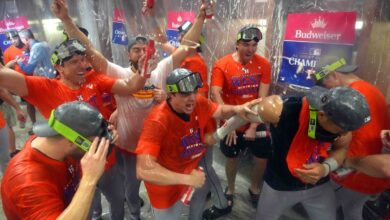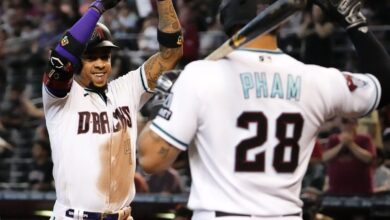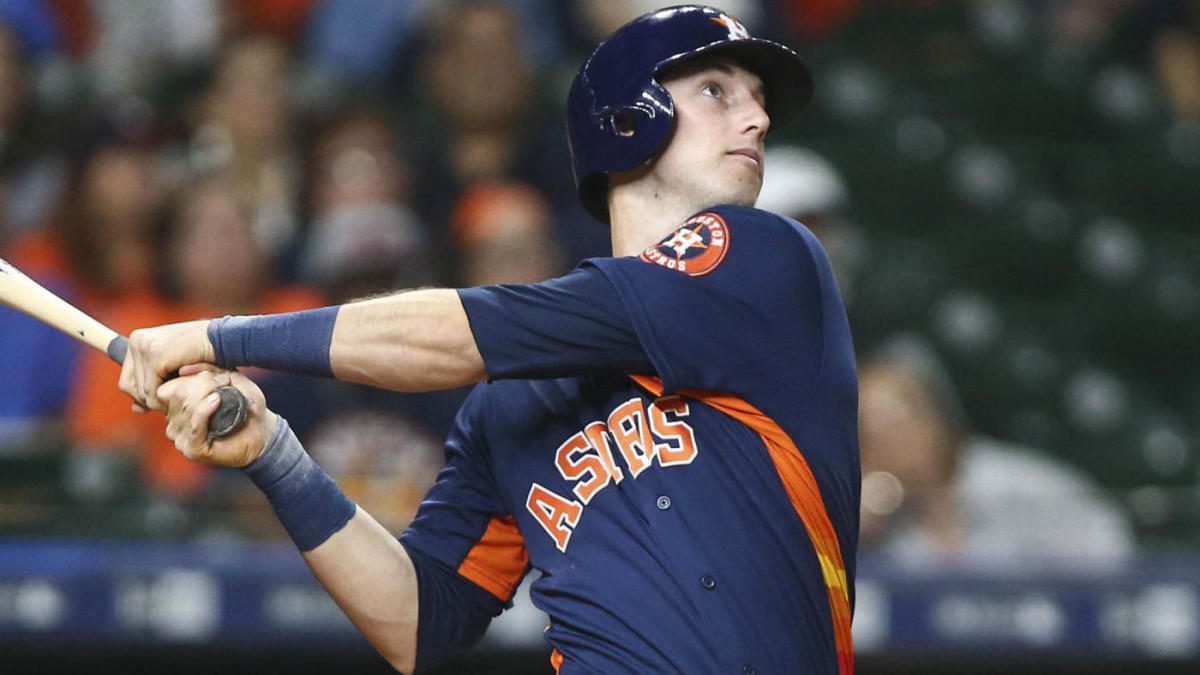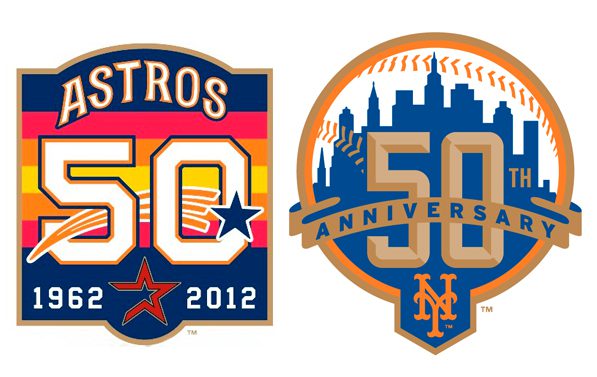
 It’s hard to argue that the biggest MLB anniversary celebration of 2012 is for “America’s Most Beloved Ballpark”, or “Pahk” — Fenway Park in Boston, which turns 100 this season. The Seattle Mariners turn 35 years old this year, and their fans may beg to differ. After all, that’s what you call dedication when you are one of 170 rabid season ticket holders cramming into Safeco Field at 3 a.m. (Pacific time) to cheer on your team as they “open” the season in Japan.
It’s hard to argue that the biggest MLB anniversary celebration of 2012 is for “America’s Most Beloved Ballpark”, or “Pahk” — Fenway Park in Boston, which turns 100 this season. The Seattle Mariners turn 35 years old this year, and their fans may beg to differ. After all, that’s what you call dedication when you are one of 170 rabid season ticket holders cramming into Safeco Field at 3 a.m. (Pacific time) to cheer on your team as they “open” the season in Japan.
Other notable anniversaries in 2012 include 20 years of ball at Camden Yards, which is the first park to start the “retro” architectural design fad for future stadiums, and the 40th anniversary of the Texas Rangers’ home in the Dallas/Fort Worth Metroplex. Then there is the place Vin Scully has called home for a half a century, Dodger Stadium in Chavez Ravine.
The Los Angeles Dodgers are the perfect segue into our next biggest anniversary of note, that of 50 years of baseball for New York’s beloved Amazin’ Mets and the Houston Astros (then Colt 45s.). When the Dodgers fled Brooklyn in 1957, it was a dagger in the heart for those who had cheered on them “bums” in Flatbush for generations. That same season, Horace Stoneham put the nail in the coffin on National League baseball in New York, when Willie Mays and the Giants shipped out to San Francisco.
Both the Houston Colt 45s and Mets are “sister” franchises, in that they were both part of National league expansion in 1962. Expanding from eight to 10 teams meant, for the first time, National League play would consist of 162 games. A year earlier, the junior circuit started playing 162 contests after the addition of two new teams, the Los Angeles Angels and Minnesota Twins.
In celebration of their 50 years, the Mets and Astros will have special events scheduled for 2012. The Astros will have “Flashback Fridays” at Minute Maid Park, when former stars will throw out first pitches and current players will wear throwback jerseys from different eras in the history of the franchise. After a little bit of controversy regarding the pistols logo in their inaugural uniform, the original Colt 45s jerseys will be worn. In addition, the funky ’70s orange and yellow jerseys will certainly be fan favorites, bringing back memories of Jose Cruz, Larry Dierker and Joaquin Andujar.
The Mets, meanwhile, will bring back the popular Shea Stadium tradition of Banner Day to Citi Field on May 27 versus the Padres. In addition, in an event which is the first of its kind, Hofstra University on Long Island will host a three-day conference in late April devoted exclusively to the history of the Amazin’ Mets.
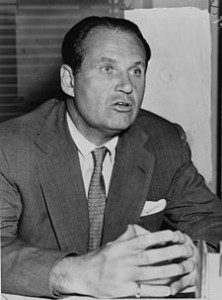
The stories of both the Mets and Astros began in the minds of two baseball obsessed visionaries in each respective city. New York attorney William A. Shea, who was once a former basketball player at Georgetown in the 1920s, spearheaded the campaign to return National League baseball to New York. While in Houston, it was former sportswriter turned PR-man George Kirksey who was Shea’s Texas counterpart.
Immediately, after the Dodgers and Giants exodus to California, New York mayor Robert Wagner, Jr. expressed his personal dismay about not having another team in town besides the Yankees. After being told by Wagner to lead a committee to bring a National League team back to New York, Shea had to deal with the reality that major league baseball didn’t care. Trying to lure other teams to New York, such as the Reds, Pirates and Phillies proved to be both expensive and useless propositions. Finding a suitable stadium would be a big stumbling block, as negotiations broke down. The only alternative was for expansion, which neither owners nor Commissioner Ford Frick wanted any part of.
Back in Houston, Kirksey faced a far more daunting task in bringing baseball to the Deep South. In the mid-1950s, Houston was 1,000 miles from the nearest major league city. Half the teams were on the east coast, while other established cities had franchises, such as Pittsburgh, Detroit and Chicago. Kirksey also tried in vain to lure other teams to town, including the Cubs and White Sox, as well as the Cincinnati Reds.
The city did have a rich history of baseball, however, with the successful Houston Buffaloes (or Buffs as they were called), who were for years a farm team for the St. Louis Cardinals. It was, in fact, general manager Branch Rickey who created what we know as the modern farm system right around the time the Texas League joined Class A status in 1921.
Kirksey needed a group of investors, and got three wealthy men on board to make his venture credible. They included William A. Kirkland, chairman of First City National Bank (Houston’s largest), Craig F. Cullinan, Jr., who was an heir to Texaco Oil, and another oil man named R.E. “Bob” Smith, Ultimately, in 1958, 28 shareholders formed what would become known as the Houston Sports Association. Former County Judge and mayor of Houston Roy Hofheinz also brought immediate political clout to Kirksey’s cause.
The relocation of the Dodgers and Giants to the west coast provoked mixed feelings for Kirksey. On the one hand, he saw that baseball spreading westward could only be a positive sign that a major league team could emerge in the South. On the other hand, Kirksey understandably felt threatened that the void left in New York would be an easy sell for a new team, all at Houston’s expense.
Kirksey and representatives from Toronto, Denver, Atlanta, Dallas/Fort Worth, Buffalo and Minneapolis, all joined forces with Shea, agreeing that the only way to create their major league franchises was to form a rival third league, which became known as the Continental League. It is the involvement of nearly 80-year old Branch Rickey in the league, however, that really got people on all sides listening.
“The people of the United States have got to have more major league baseball,” said Rickey. “They demand it and we in baseball are obligated to give it to them”.
The Continental League contingent won out in the end after successfully challenging the long-held reserve clause with Senate subcommittee bill 3483. Although the bill did not pass, it threatened the blanket protection baseball had received from antitrust violations since a 1922 Supreme Court decision regarding the Sherman Act and interstate businesses. The 3483 bill, in effect, limited each major league team to owning a total of 100 players over an extended period of time (40 outright and 60 others in the first four years of their professional careers). The other significant components of the bill regarded blocking the prevention of alternative leagues and limiting exclusive broadcast rights to a 75-mile radius.
An agreement was finally reached in October 17, 1960, in Chicago. After contentious debate between all parties involved, a compromise was reached. It was decided that if the Continental League officially agreed to disband, two former Continental League cities would be awarded an expansion team in each major league. The American League expanded to both Minneapolis and, surprisingly, Los Angeles. Both Shea and Dodgers owner Walter O’Malley, were livid when the junior circuit decided to put an expansion team in a non-Continental League city. Shea got what he wanted, however, as National League baseball was returning to New York. Houston was the other new franchise. Both would begin play in 1962.
As to whether the Continental League would have actually succeeded is anyone’s guess. The question is in the end irrelevant. As Kirksey said, “If the Continental League is dead, it is the livest ghost walking the baseball orchards.” Cullinan added, “It was ridiculed as a sham, but on the contrary it was an enormous success because it ran what became the biggest bluff in the history of professional sports.”
With the news of a New York franchise, high society team owner Joan Payson, became the first woman to own a major league franchise by means other than inheritance. On May 8, 1961, after a total of 644 suggested nicknames, the nameless team became the New York Mets. It didn’t matter that the team had no players, manager or even their own stadium (the ballpark that opened in 1964 would, of course, be named Shea Stadium). Nor did it matter that this new franchise was about to lose 120 games its first season. The only thing important thing was, after five dark years in the Big Apple, National League baseball was back in New York.
Meanwhile, in Houston, a Texan by the name of William Irving Nader won a “name the team” contest with his entry of “the Gun that Won the West.” George Kirksey’s dream of a major league ballclub in Houston was fulfilled with the newly born Colt 45s. After three seasons, upon newly being named the Astros, the team moved into the first air-conditioned, fully domed “Eighth Wonder of The World,” known as the Astrodome.


